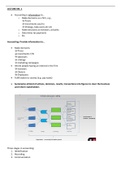Summary
Accounting exam preparation summary
- Course
- Institution
This document is a summary that contains not only the lecture slides but notes based on what professors said and explained that cover all of what there is to know about the course accounting in the first year of IBA. Furthermore, this summary contains and explains exercises that can prepare you for...
[Show more]



